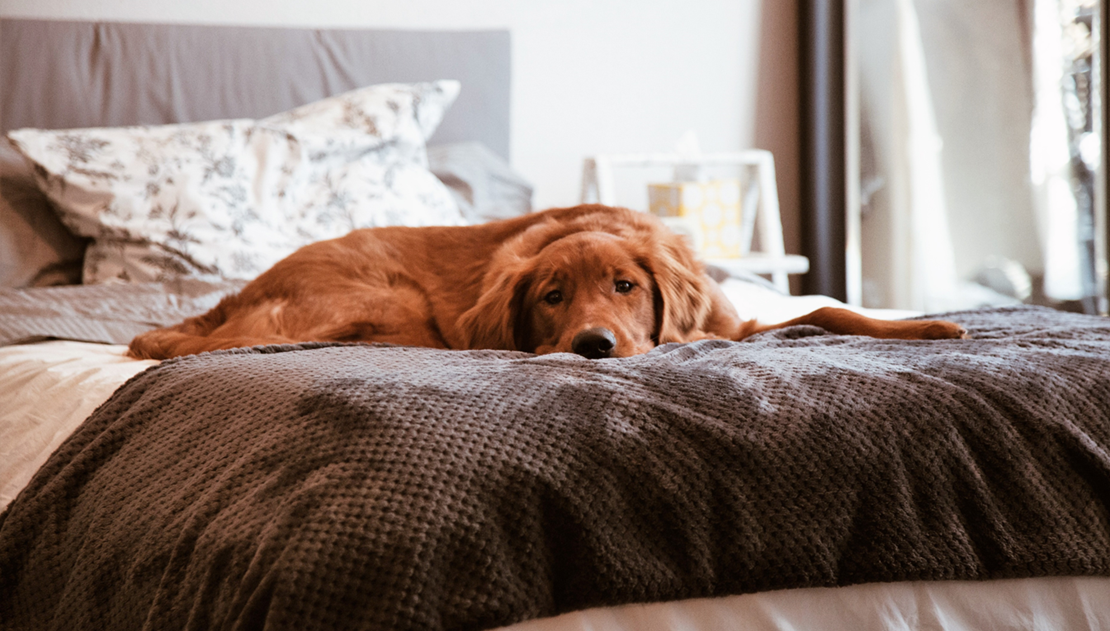Dogs are considered man’s closest companions. Known for their loyalty and seemingly natural willingness to please people, they can bring cheer into any home. However, just like humans, dogs can experience anxiety. Although unpleasant, this emotion is normal, can be healthy and affects all breeds. For many pet owners, it’s the first time we are learning about these things. Read along as we discuss relevant FAQs on dog anxiety and how to protect them.
- About dog anxiety
- What causes a dog to be anxious?
- How to calm an anxious dog?
- How can I prevent my dog from getting anxious?
- How can I protect my dogs?
About dog anxiety
Anxiety is something all dogs may experience from time to time. A change in their routine or sudden exposure to loud noises, for example, can bring about significant changes in their behaviour. If high anxiety levels are left unchecked, an anxious dog can develop an anxiety disorder, leading to behavioural issues such as aggression.
It may be a good idea to consult a veterinary behaviourist to manage or treat dog anxiety and aggression. They can help pet owners identify the type of anxiety or aggression a dog suffers from and identify the possible triggers. Installing security cameras in the dog’s area can help owners monitor their pets when they’re not home. They can also share the video with their veterinarian to help with the diagnosis.

What causes a dog to be anxious?
A 2020 study of 13,700 dogs showed that genetics could prompt anxiety and stress in canines . About 72.5% of dog participants exhibited at least one anxiety-related behaviour. We list some possible reasons and causes why dogs get anxious.
1. Fear or anxiety-related aggression
Strangers, loud noises, visual stimuli, and specific situations may trigger aggression, preceded by fear and anxiety. Although some anxious dogs may only experience a brief reaction to these situations, they may affect them more consequentially. If a dog is experiencing fear or anxiety-related aggression, its health and emotional welfare are likely compromised.
2. Separation anxiety
Research shows about 14% of dogs experience separation anxiety. Anxious dogs with this condition are unable to find comfort when they’re left alone. Often, separation anxiety manifests in undesirable behaviours, such as defecating and urinating in the house, continuous barking, excessive licking, and destroying furniture.
One way to calm an anxious dog is to find out what or who it is they are afraid of being separated from.
3. Age-related anxiety
This condition affects older dogs and is sometimes associated with cognitive dysfunction syndrome (CDS).
Dogs with CDS experience symptoms similar to the early stages of Alzheimer’s disease. In dogs with CDS, perception, memory, learning, and awareness begin to decline. Such a condition leads to anxiety and confusion in senior dogs.
How to calm an anxious dog
Most people might think medication is necessary to calm their pet’s anxiety. However, many alternative treatments can work, too. We list some natural remedies for dog anxiety.
1. Exercise

An anxious dog may sometimes mirror its owner’s stress. If a busy work schedule means an owner isn’t taking their dog for regular walks, it may feel more anxious. Loneliness and the change in routine are all possible contributors to stress. However, they may be eliminated by taking a dog outside to stretch its legs and get some fresh air.
2. Music
A 2017 study showed that the right music could be effective in reducing signs of dog anxiety. Researchers found that reggae and soft rock music were the most effective, although individual dogs had distinct preferences.
3. Vet-recommended natural extracts
Some dog owners have used alternative treatments like hemp extracts for behaviour management. Studies show that cannabidiol may help facilitate serotonin’s effects in a dog’s body. Serotonin is a neurotransmitter that regulates behaviour, mood, and appetite.
CBD (cannabidiol), found in hemp and cannabis, may benefit humans and animals alike. When asked about the potential benefits of CBD products, veterinarians reported in a survey that CBD was most helpful for chronic pain by 34%, followed by acute pain, 23%. Some veterinarians also said that CBD helped decrease anxiety and seizure frequency by over 75%.
4. Acupuncture
Acupuncture is an ancient Chinese medication. The procedure involves inserting needles through the skin to stimulate particular points in the body. Research suggests that acupuncture may help stimulate the release of the body’s pain-relieving substances. These substances may also help treat stress and lessen anxiety.
Acupuncture is actually painless for small animals like dogs. Owners have reported that their anxious dogs became calm or sleepy when the needles are already in place. It is highly recommended to have a veterinary behaviourist develop and oversee any acupuncture protocol.
5. Grooming
Dog owners may opt to groom their dog by brushing its fur every night. This form of pampering may feel great for an anxious dog as it gets more time and attention from its owner, reducing anxiety.
Dog owners will also have a chance to observe their dog’s skin for any lesions or abrasions due to excessive licking.
6. Massage
Massage therapy may also be helpful. Essential oil can help an anxious dog calm down and relax during the massage. The owner may rub a few drops of essential oil on the dog’s paws for it to lick.
But be mindful that some oils can be quite toxic to animals, especially if they have a cat in the household. Always check with your vet.
How can I prevent my dog from getting anxious?
There are ways to help dogs avoid anxiety-related problems but it’s difficult to predict what makes a dog anxious. It’s even harder to determine if a dog’s anxiety will lead to a more severe disorder, resulting in behavioural issues. We explore some options that your vet may recommend.

1. Socialisation
Proper socialisation may help prevent dogs feel anxious. An owner may introduce their dog to new people or other animals to avoid exaggerated responses down the road. Monitor how your dog interacts and if you can see that your dog is feeling comfortable, then socialisation may be a good way to start. However, once you notice that your dog is not doing well with socialisation, they take a step back as it may trigger anxiety for your dog.
2. Situation avoidance
If a dog is diagnosed with anxiety and shows signs of aggression, the owner should avoid situations that may trigger its anxiety. When a dog becomes increasingly aggressive, an owner may also use preventive measures like body harnesses, leashes, and basket muzzles. Once the owners know their dog’s triggers, they can prepare for these circumstances ahead of time. It is important to document this because it can also help educate the people around the house.
Seek protection for your furry friends
Dog parenting involves being sensitive to the emotional state of one’s canine companion. If your dog is suffering from anxiety or exhibiting aggression, it’s recommended to seek help from a licensed veterinary behaviourist, not just for your furry friend, but also for your peace of mind. The sooner treatment is sought, the better chance for improvement.
Did you know that Knose offers optional extra benefits which provides pet insurance cover for behavioural problems and alternative therapies? Give our dog insurance a try and include in your quote added optional extra benefits.
More resources related to dog health:
- Knose Dog Insurance
- Knose Pet Insurance Cover Explained!
- Why Is Pet Insurance Important in Australia?
- Pet Behavioural Helpful Tips
- 4 Tips for Stress-Free Holidays with Pets
Post by Casey Bloom in collaboration with Knose Pet Insurance



